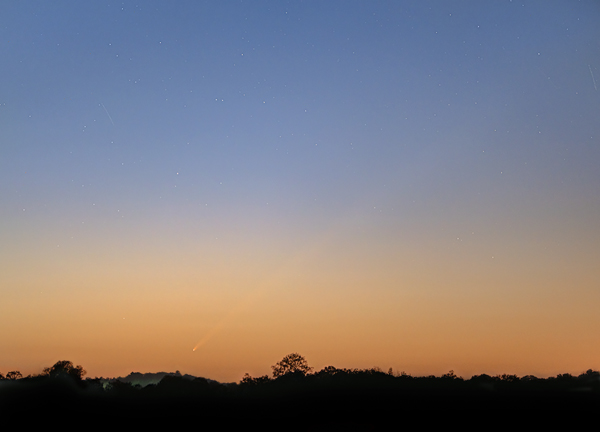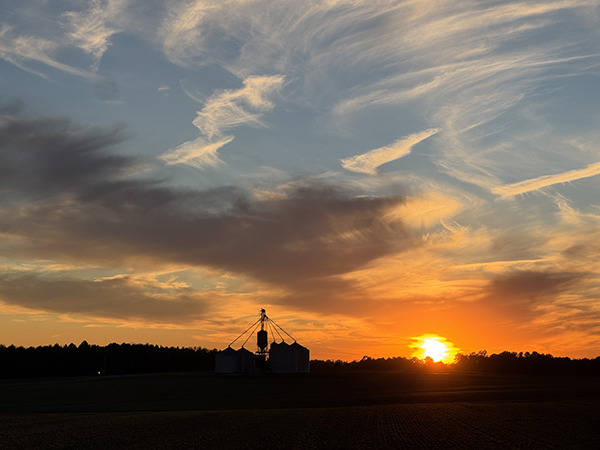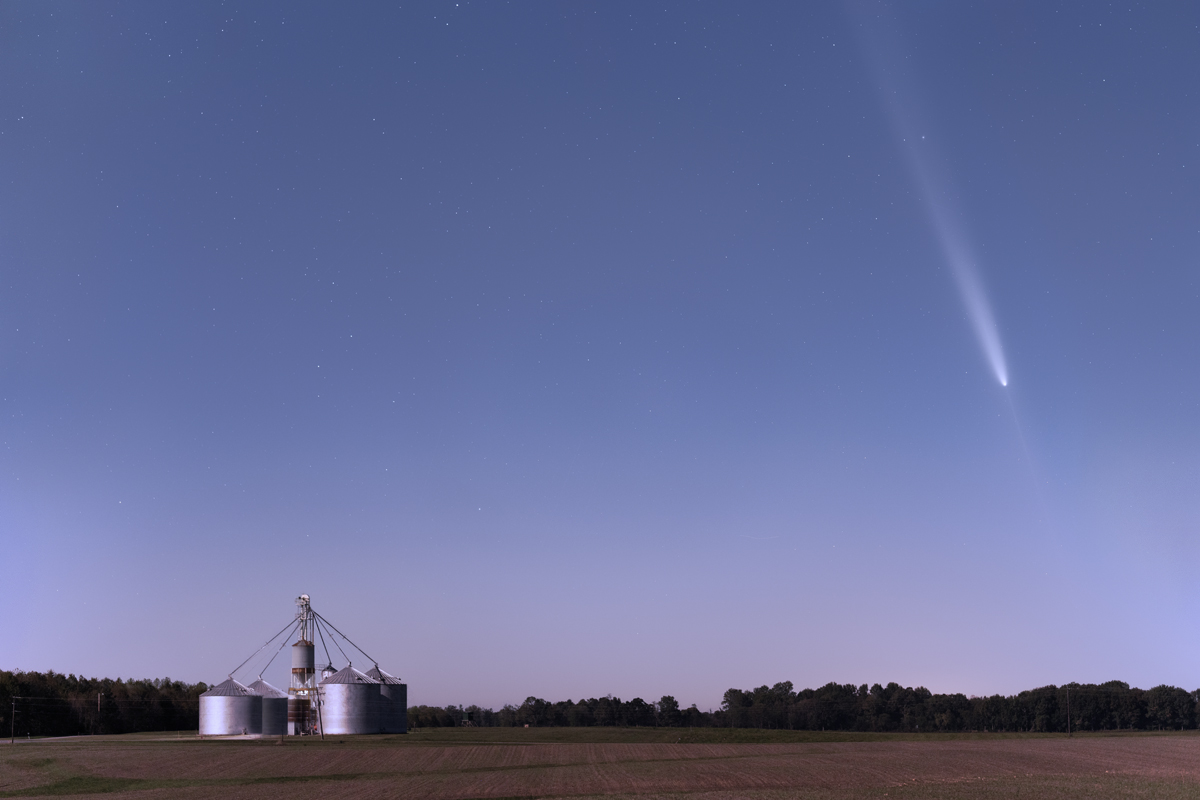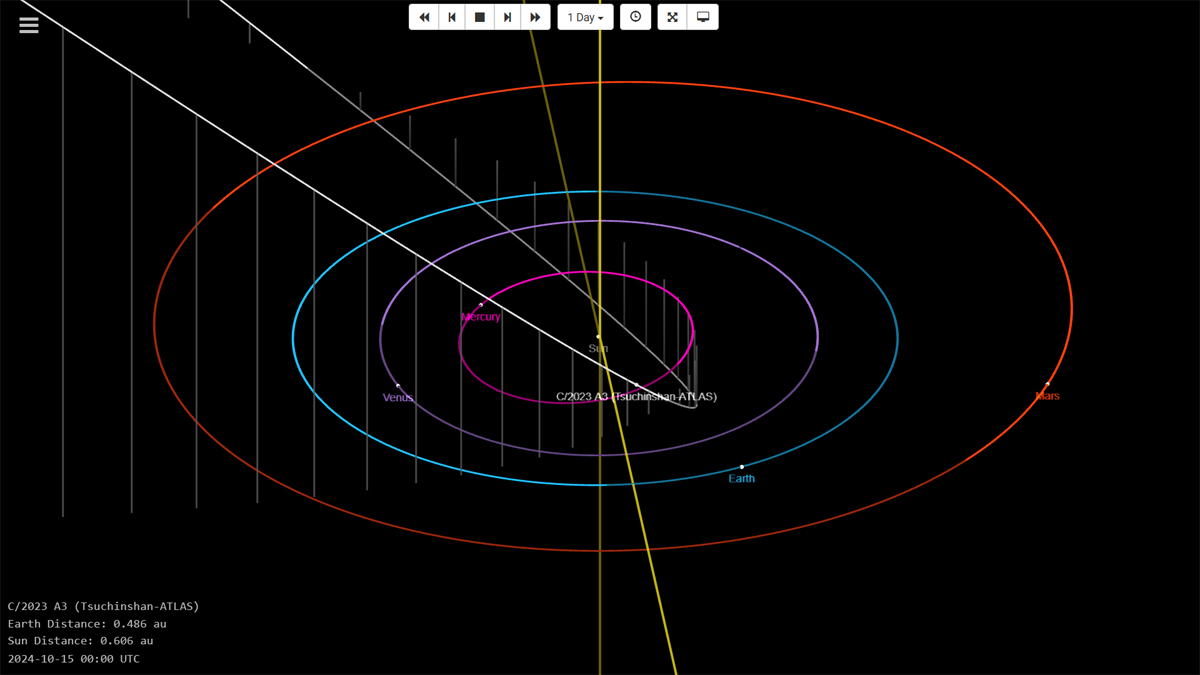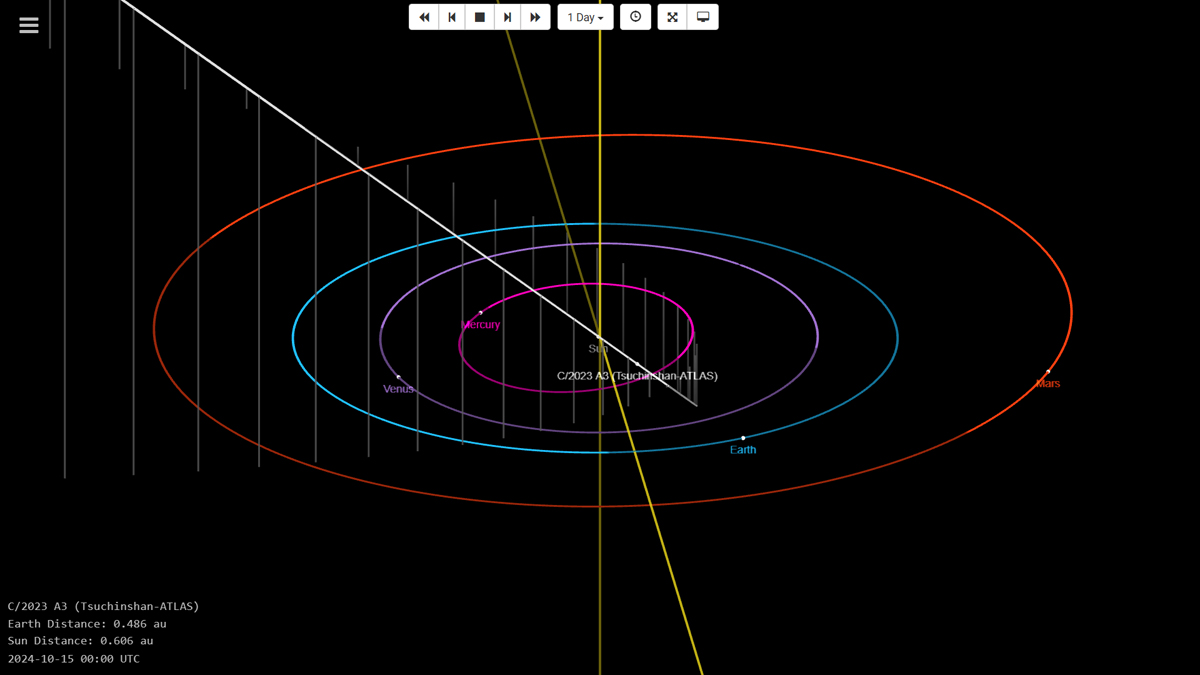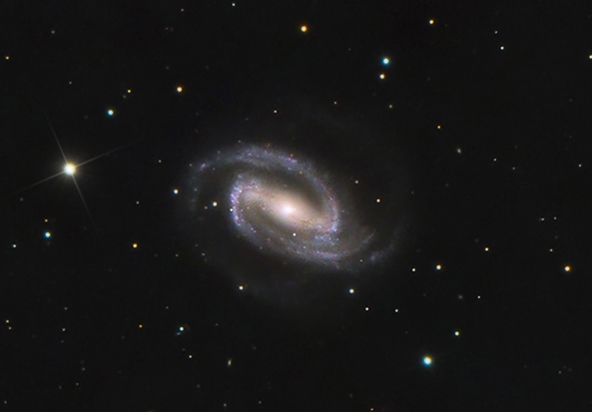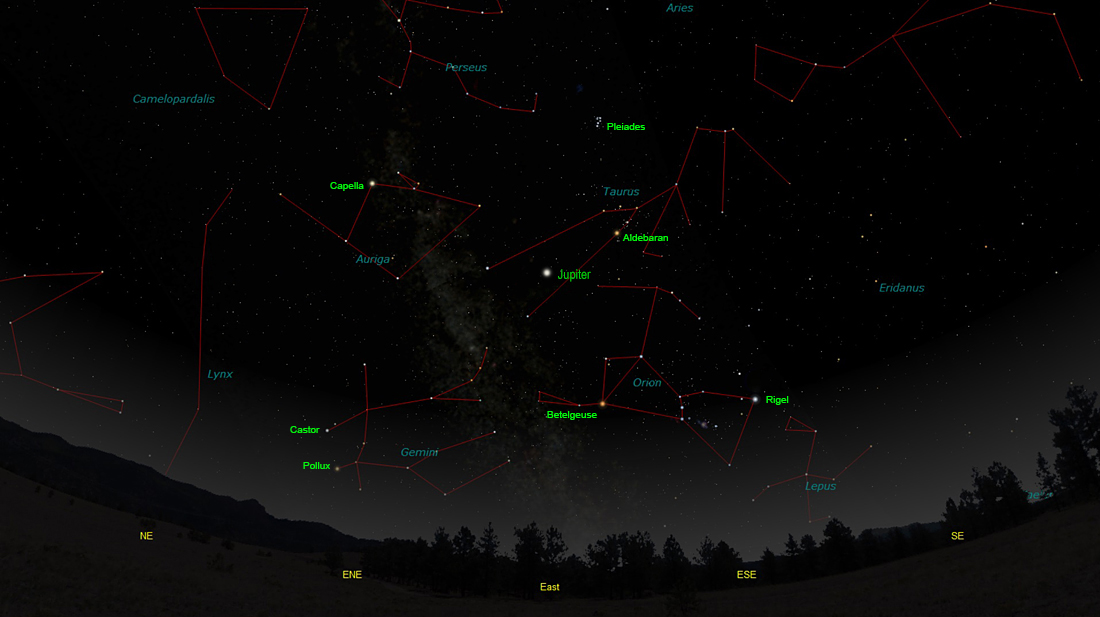The purpose of this feature is to give scout leaders, educators and naturalists an idea of some of the natural events coming up each month. We will try to cover a variety of natural events ranging from sky events to calling periods of amphibians, bird and mammal watching tips, prominent wildflowers and anything else that comes to mind. We will also note prominent constellations appearing over the eastern horizon at mid-evening each month for our area for those who would like to learn the constellations. If you have suggestions for other types of natural information you would like to see added to this calendar, let us know! Though we link book references to nationwide sources, we encourage you to support your local book store whenever possible.
Notes and Images From October 2024
Our earlier tries were frustrated by clouds and we didn't get clear weather until October 2nd, when the comet was rapidly fading into the bright morning twilight. It was just too close to the Sun to get a detailed view, but we did get an image of the long, faint gossamer tail extending most of the way across the image at right. We needed a low eastern horizon for the shot, so we got up around 2:30am and drove west to the starting point of the Squeeze Bottom TAMP route. We set up the camera under a crystal clear sky, but the comet was not visible to the naked eye. It was simply too close to the Sun. By 6:00am we were done and headed back home.
I returned to the area on October 14th. This part of Kentucky is largely agricultural, and I wanted to show one of the granaries in the image of the comet. Once again it looked like the clouds might spoil the view of the comet. The image at right shows the area at sunset that evening. I decided to just relax and take a drive around the area, checking out the little nearby town of Herndon. When I returned an hour later I was surprised to find that the sky was rapidly clearing in the west. The sunset colors faded and a bright gibbous Moon rising in the eastern sky illuminated the fields and granary, giving everything a silvery cast. Despite the moonlight the comet was easily visible to the naked eye, though dimmer and more diffuse than the camera's view. I was comfortable with the camera setup now, and that meant I could relax and just enjoy the evening. Many of the agricultural fields around me had been recently harvested and the whole area was a raptor paradise. American Kestrels and Red-tailed Hawks were abundant earlier in the day, and Northern Harriers cruised low over the fields. Now as the light faded, a male and female Great Horned Owl called back and forth from a distant tree line. This is the beginning of their courtship period. A pack of coyotes started yipping nearby. A single "hooo-awww" call from a Barred Owl drifted across the fields. The camera was on a tracking mount, so all I had to do was just click the shutter once and it would take a series of 16 exposures. The brightest "star" in the tail of the comet in the image below is actually the globular star cluster Messier 5.
When I began looking at each series I noticed how prominently visible the "anti-tail" had become. The term is misleading, in that there is nothing actually projecting from the head of the comet in the direction opposite of the tail and towards the Sun. It's an effect produced by our perspective of the material scattered along the comet's orbit that we are seeing. The two images below may help visualize why we see the "anti-tail". Both were made using NASA's Horizon Orbit Viewing Tool. In the first image below you see Earth's orbit in blue, with a white dot showing Earth's location. Both charts were made for 00:00 hours Universal Time (UT) October 15th, which equates to around 7:00pm CDT on October 14th, when I was taking the above image. The orbit of the comet is shown in white with a white dot showing the comet's location at that time. There's no clue why you might see the anti-tail.
The comet was outward bound in our images and is estimated to return in around 80,000 years. It is now still visible in small telescopes, but is fading as it heads away. As Carl Sagan and Ann Druyan said in their book, Comet, "Like a breaching whale before it plunges into the ocean depths, a comet briefly luxuriates in the sunlight and then is gone".
Sky Events for November 2024: The Leonid Meteor Shower peaks during the morning hours of November 17th. A couple of lounge chairs, a blanket or sleeping bag, and a hot beverage will probably add to your enjoyment. Just face east and enjoy the night. Though this is not presently the most active meteor shower, you should still see a few meteors. A waning gibbous Moon will reduce the number of meteors visible. Evening Sky: Venus still shines brightly in the western sky after sunset this month. It is brighter than any other star-like object in the sky, so you shouldn't have a problem locating it. Start looking about 15 minutes after sunset. Mercury is highest above the western horizon on November 19th, though it is still only about 5 degrees above the horizon thirty minutes after sunset. Unless you have a very clear sky and a low horizon it may be tough to pick it out of the twilight glow. Saturn is due south around 9:00pm at the beginning of the month, about 45 degrees above the horizon. The view is spectacular in just about any aperture telescope. The Moon passes just below Saturn on November 10th, and both can be seen in the same low power view of a telescope.
There's a lot to see on Jupiter. Even with just a good pair of binoculars you can see Jupiter appears as a small disk rather than a star like point. You can often see one or more of the four Galilean moons. One of Galileo's great discoveries were these four moons, though the names presently used (Io, Europa, Calisto and Ganymede) were suggested by his archrival Simon Marius. The movement of the moons is noticeable even over the course of one evening. A six-inch aperture telescope will show the Great Red Spot, a long-lasting, Earth-sized storm in Jupiter's clouds shown in the image at right, and some of the belts, though the belts have lower contrast visually than they appear in images. The planet rotates in just under 10 hours, so in a single night you can watch the Great Red Spot rotate from one side of the planet to the other. Mars rises about five hours after sunset at the beginning of the month. The red planet is brightening as it approaches its January 16th opposition. Look for it in the coming months it. It will show its color much more, looking like a red glowing coal against the black sky. It begins the month appearing 9.5 seconds of an arc in diameter and ends the month at 10.5 seconds - large enough to show some surface detail to a patient observer.
Constellations:
Auriga, the Charioteer, with its bright star Capella, is prominent in the northeast. Look for the bright stars Castor and Pollux as the constellation Gemini, The Twins, clears the horizon. In the southeast, mighty Orion clears the horizon with its bright stars Betelgeuse and Rigel. Note the difference in color between the two stars. Betelgeuse is a red giant and looks orange. Rigel is a very hot supergiant and looks bluish. Looking at the center of the three "sword" stars with binoculars, you can see M42, the Orion Nebula. Just poking its head above the horizon is Lepus, The Hare. Look above the bright star Aldebaran in Taurus to spot the Pleiades, or the Seven Sisters. Above the southeast horizon are the stars of Eridanus, the River. The river begins near Rigel, at the foot of Orion, and winds its way down to the horizon and disappears below it. It ends in the bright star Achernar, which never rises above our southern horizon. Along its path lies the beautiful barred spiral galaxy NGC 1300, shown in the image above. This galaxy is almost 70 million light-years away.
On Learning the
Constellations: We advise learning a few constellations each month, and then following them through the seasons. Once you associate a particular constellation coming over the eastern horizon at a certain time of year, you may start thinking about it like an old friend, looking forward to its arrival each season. The stars in the evening scene above, for instance, will always be in the same place relative to the horizon at the same time and date each November. Of course, the planets do move slowly through the constellations, but with practice you will learn to identify them from their appearance. In particular, learn the brightest stars for they will guide you to the fainter stars. Once you can locate the more prominent constellations, you can "branch out" to other constellations around them. It may take you a little while to get a sense of scale, to translate what you see on the computer screen or what you see on the page of a book to what you see in the sky. Look for patterns, like the stars that make up Orion. The Earth's rotation causes the constellations to appear to move across the sky just as the Sun and the Moon appear to do. If you go outside earlier than the time shown on the charts, the constellations will be closer to the eastern horizon. If you observe later, they will have climbed higher. As each season progresses, the Earth's motion around the Sun causes the constellations to appear a little farther towards the west each night for any given time of night. The westward motion of the constellations is equivalent to two hours per month. Recommended: Sky & Telescope's Pocket Star Atlas is beautiful, compact star atlas. A good book to learn the constellations is Patterns in the Sky, by Hewitt-White. For sky watching tips, an inexpensive good guide is Secrets of Stargazing, by Becky Ramotowski.
A good general reference book on astronomy is the Peterson
Field Guide,
A Field Guide to the Stars and Planets, by Pasachoff. The book retails for around $14.00.
The Virtual Moon Atlas is a terrific way to learn the surface features of the Moon. And it's free software. You can download the Virtual Moon Atlas here. Apps: The Sky Safari 6 basic version is free and a great aid for the beginning stargazer. I really love the Sky Safari 6 Pro. Both are available for iOS and Android operating systems. There are three versions. The Pro is simply the best astronomy app I've ever seen. The description of the Pro version reads, "includes over 100 million stars, 3 million galaxies down to 18th magnitude, and 750,000 solar system objects; including every comet and asteroid ever discovered." You may also want to try the very beautiful app Sky Guide. Though not as data intensive as Sky Safari, Sky Guide goes all out to show the sheer beauty of the night sky. Great for locating the planets. A nother great app is the Photographer's Ephemeris. Great for finding sunrise, moonrise, sunset and moonset times and the precise place on the horizon that the event will occur. Invaluable not only for planning photographs, but also nice to plan an outing to watch the full moon rise. Available for both androids and iOS operating systems.
Amphibians:
Recommended: The Frogs and Toads of North America, Lang Elliott, Houghton Mifflin Co.
Archives (Remember to use the back button on your browser, NOT the back button on the web page!) Natural Calendar September 2024 Natural Calendar February 2024 Natural Calendar September 2023 Natural Calendar February 2023 Natural Calendar September 2022 Natural Calendar February 2022 Natural Calendar December 2021 Natural Calendar November 2021 Natural Calendar September 2021 Natural Calendar February 2021 Natural Calendar December 2020 Natural Calendar November 2020 Natural Calendar September 2020 Natural Calendar February 2020 Natural Calendar December 2019 Natural Calendar November 2019 Natural Calendar September 2019 Natural Calendar February 2019 Natural Calendar December 2018 Natural Calendar September 2018 Natural Calendar February 2018 Natural Calendar December 2017 Natural Calendar November 2017 Natural Calendar October 2017Natural Calendar September 2017 Natural Calendar February 2017 Natural Calendar December 2016 Natural Calendar November 2016 Natural Calendar September 2016Natural Calendar February 2016 Natural Calendar December 2015 Natural Calendar November 2015 Natural Calendar September 2015 Natural Calendar November 2014 Natural Calendar September 2014 Natural Calendar September 2013 Natural Calendar December 2012 Natural Calendar November 2012 Natural Calendar September 2012 Natural Calendar February 2012 Natural Calendar December 2011 Natural Calendar November 2011 Natural Calendar September 2011 Natural Calendar December 2010 Natural Calendar November 2010 Natural Calendar September 2010 Natural Calendar February 2010 Natural Calendar December 2009 Natural Calendar November 2009 Natural Calendar September 2009 Natural Calendar February 2009 Natural Calendar December 2008 Natural Calendar November 2008 Natural Calendar September 2008 Natural Calendar February 2008 Natural Calendar December 2007 Natural Calendar November 2007 Natural Calendar September 2007 Natural Calendar February 2007 Natural Calendar December 2006 Natural Calendar November 2006 Natural Calendar September 2006 Natural Calendar February 2006
Natural Calendar December 2005
Natural Calendar November 2005
Natural Calendar September 2005
Natural Calendar February 2005
Natural Calendar December 2004
Natural Calendar November 2004
Natural Calendar September 2004
Natural Calendar February 2004
Natural Calendar December 2003
Natural Calendar November 2003 Natural Calendar February 2003 Natural Calendar December 2002 Natural Calendar November 2002 Nature Notes Archives: Nature Notes was a page we published in 2001 and 2002 containing our observations about everything from the northern lights display of November 2001 to frog and salamander egg masses. Night scenes prepared with The Sky Professional from Software Bisque All images and recordings © 2024 Leaps
|
|
